What’s the point of building a QA team if you don’t want it to thrive, right? Operational efficiency and effective collaboration are the two things that make it happen.
Enter workflow integration. It’s a method of connecting different tools and processes together. Teams are also adjusted in this loop, so everything becomes smooth. Doing so helps organizations to automate repetitive tasks. Resource utilization is also optimized, causing the overall productivity to improve.
For companies engaged in things like software development and quality assurance. Integrating workflows, especially with a good test management tool, is a strategic move. It accelerates product delivery without compromising quality.
This article will define workflow integration and explain its benefits. We’ll also explore its value through practical business examples, with a particular focus on the QA ecosystem.
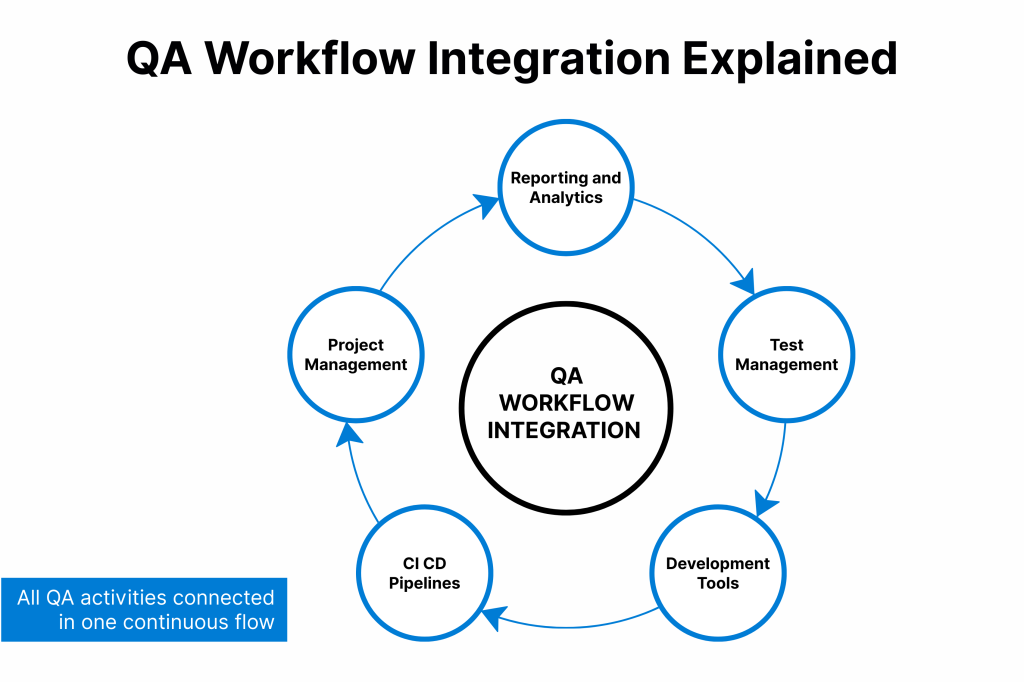
Key Takeaways
- QA workflow integration helps teams work faster by removing manual steps and repeated work.
- When QA tools are connected with dev and project tools, everyone sees the same updates at the same time.
- Automation saves time and reduces mistakes. Tests run on their own, and bugs are logged automatically.
- Having all QA data in one place makes decisions easier and quicker for managers.
- Tools like Kualitee make this simple by connecting QA, development, and reporting in one system.
What is QA Workflow Integration Exactly?
It’s a process of connecting different tools, systems and processes so that information and tasks flow naturally between them. Manual handoffs, data silos, and isolated efforts are ditched.
The integrated workflows automate the transfer of information and reduce errors to provide complete visibility across the business.
Main Elements:
- Automation: Replacing manual interventions with automatic actions and triggers.
- Interoperability: Ensuring that different systems. i.e., test management tools, development tools, can communicate and share data.
- Centralization: Creating a unified source of truth. This is particularly important for QA teams that rely on multiple platforms.
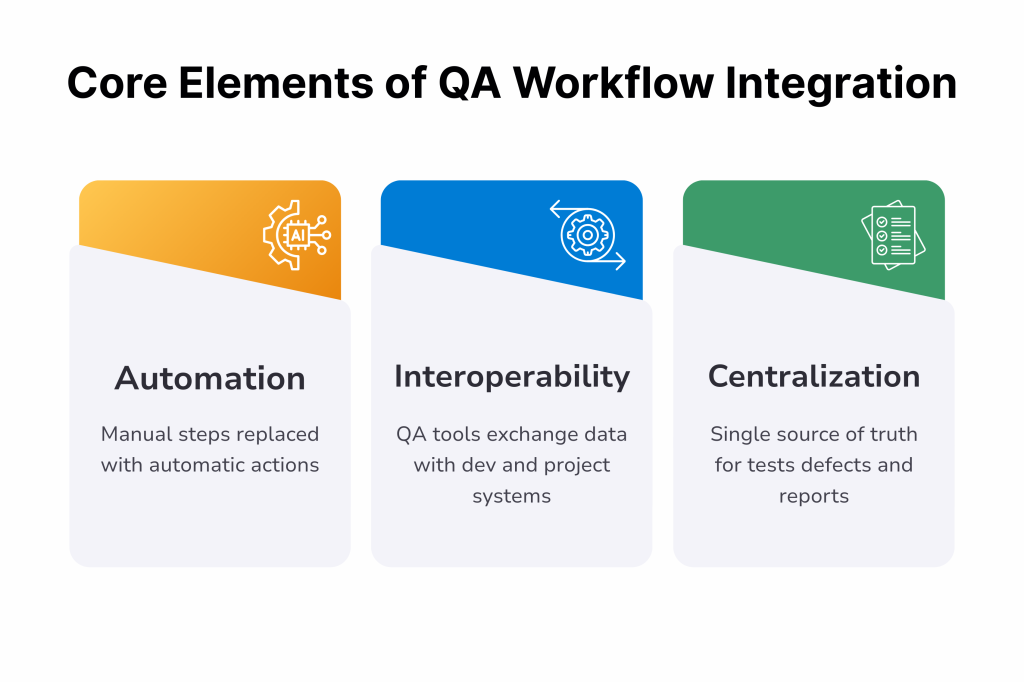
Typical Workflow Integrations Examples
Some common workflow integration examples from the real world are as follows:
- Linking a test management tool with Monday.com to automatically create and assign tasks from failed test cases.
- Syncing a QA testing tool with GitHub to update developers about issues in real-time.
- Automating notifications in Redmine when a key step in the quality assurance process fails.
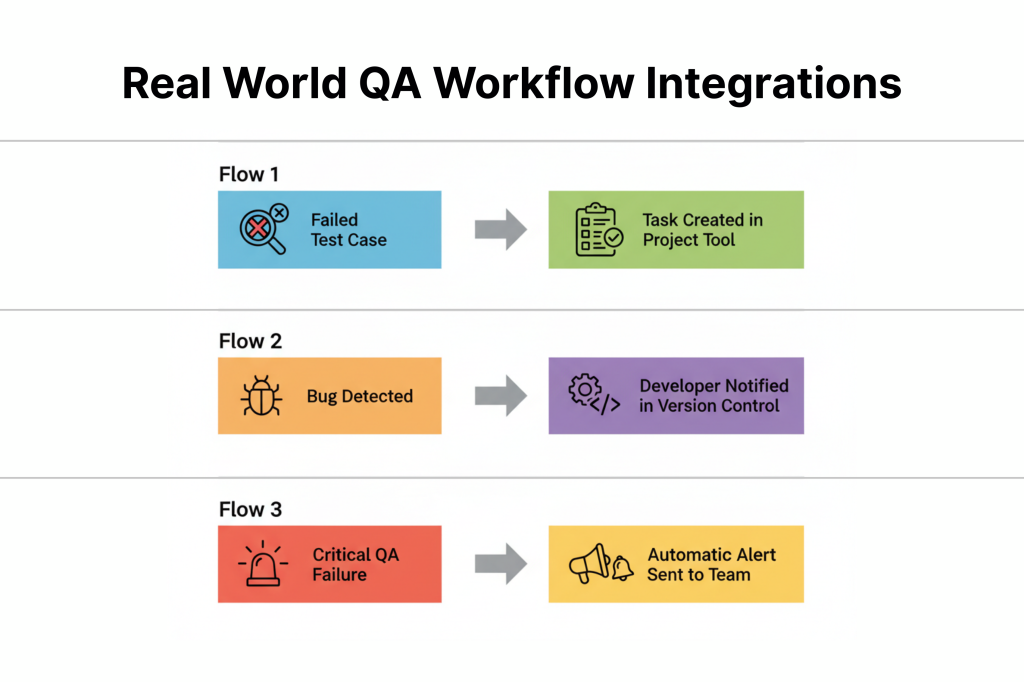
Why is QA Workflow Integration So Important?
You might ask why we’re going on and on about workflow integration. Well, it’s because this is not optional. It’s a competitive necessity for modern businesses.
Organizations that lack integration risk suffering from:
- Delayed decision-making due to slow information flow.
- Higher risk of human error from duplicate data entry.
- Increased operational burden and staff burnout.
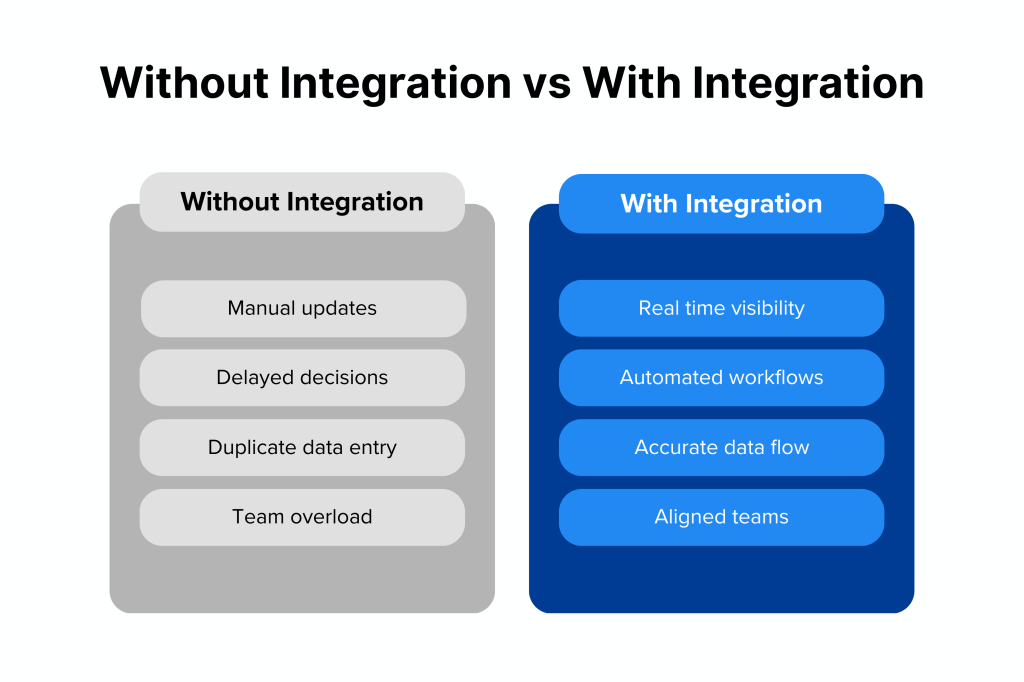
There is no good reason not to implement workflow integration. All you get are benefits. And speaking of benefits, let’s talk about them.
Major Benefits of Workflow Integration in QA
We’ve noticed the following general benefits of implementing it in QA ourselves.
1. Increased Efficiency
Integrated workflows eliminate redundant steps. For instance, with a test management tool connected to a CI/CD pipeline. Test cases are automatically triggered with every code commit. This saves a huge chunk of time and effort.
2. Improved Collaboration
Once integration is implemented, cross-functional teams. Like development, QA and product management can access real-time data.
This transparency ensures that everyone is aligned. Leading to reduced miscommunications and faster issue resolution.
3. Enhanced Quality and Consistency
When a QA testing tool is linked directly with requirements and other bug tracking platforms, you get accurate tracking. Every bug, every test case and change is visible.
What this does is ensure consistent quality standards. And the audit trails become easier to follow for regulatory compliance.
4. Scalability
As your team and product grow, manual processes become bottlenecks. Integrated workflows can be scaled easily. Larger datasets, teams and projects are accommodated instantly without much manual effort.
5. Way Better Decision-Making
Perhaps the best part about workflow integration is centralized repositories. A good quality assurance software provides decision-makers with real-time insights in one place.
It takes data like the test coverage, defect rates and the overall project health from different tools and unifies them. You don’t have to juggle between platforms and carry out human conversations to know these things. Decisions can be made quickly this way.

Key Components of a Successful QA Workflow Integration
To maximize the integration’s value, organizations need to focus on a few important components. Which are:
- Tool Compatibility and API Access: Choose a QA testing tool that offers open APIs or native integrations. Especially with other enterprise systems.
- Process Mapping: Clearly define every step that your team has to take. From test case creation to defect closure. Also, identify places where automation will save the most time.
- Automation Workflows: Make use of integrations that support “if-this-then-that” logic. For example, “if a test case fails, then create a bug in the tracking system and notify the relevant team.”
- User Access and Permissions: Ensure that the tools that are integrated respect the organizational security protocols. They should have access controls so sensitive QA data doesn’t show up for everybody.
- Continuous Improvement: Monitor the performance of the integration. Collect team feedback and make changes accordingly. Always keep in mind that the most effective workflow integrations are those that evolve with business needs.
Why Kualitee Excels for QA Workflow Integration
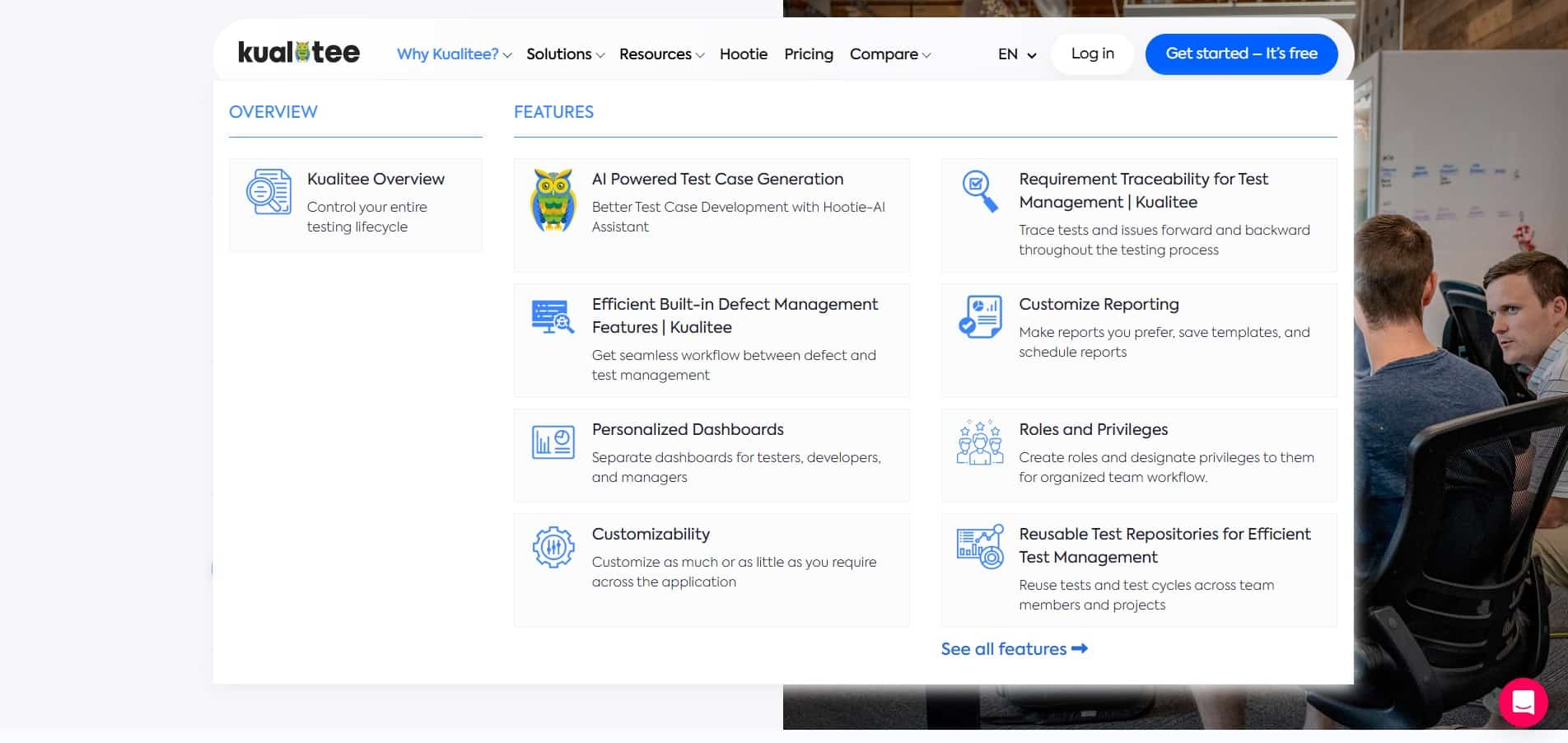
Kualitee stands out as a great test management platform. It can be helpful, particularly for organizations that are aiming to integrate and streamline their QA workflows. Some of the reasons Kualitee excels in this domain are:
- Integrations with Leading Tools:
Kualitee offers smooth integrations with popular development and project management tools. Jira, Jenkins, GitHub, to name a few. This connectivity ensures that QA teams can sync test cases and defects across platforms.
- Comprehensive Test Management:
From test planning and execution to defect tracking and reporting. Kualitee provides a centralized platform that helps teams make their QA process smooth. This end-to-end test management ensures thorough software testing before release.
- Customizable Workflows and Reporting:
Each team has unique processes. And Kualitee recognizes that. It allows for the customization of test case execution procedures. Not just that, reporting formats and defect-tracking processes can also be changed.
- Real-Time Analytics and Dashboard:
With Kualitee, teams get intuitive dashboards. Ones that show real-time insights into test execution status and defect trends. The overall software quality can also be determined from there.
- AI-Powered Test Case Generation:
An AI assistant, Hootie, is offered by Kualitee. With it, teams can automate the creation of detailed test scenarios based on requirements. The feature accelerates the test setup process.

Business Examples of QA Workflow Integration with Kualitee
Below are a few examples where QA workflow integration using Kualitee can be most beneficial.
Example # 1: E-Commerce QA Integration
Let’s say an e-commerce business integrates Kualitee with its customer support and defect resolution systems.
If a payment bug is detected, an alert will be sent to the support team. Who will then generate a ticket in the service desk. Kualitee will reflect this, and all further communication will be logged for compliance.
Example # 2: Software Development and Testing
Take a software testing company that has integrated Kualitee with GitHub and Jira. Every pull request will automatically trigger a full regression suite.
If a test fails, a defect will automatically be created in Jira. It’ll be assigned to the relevant software engineer and tracked until resolved. Also, the reporting dashboards will offer real-time updates for management.
Example # 3: Regulated Industries (Healthcare, Finance)
Think of companies working in regulated spaces like healthcare and fintech. If they connect Kualitee to compliance audit tools for defect management. Every test run and issue will be linked to the compliance documentation.
This will ensure traceability and provide a complete audit trail. Manual checking and preparation for external reviews will be reduced.
Final Words
Effective QA workflow integration improves operational efficiency and collaboration within teams.
It enables organizations to automate tasks and improve productivity. Higher-quality software products are delivered due to this.
Furthermore, a good test management tool like Kualitee helps organizations streamline their QA processes and ensure continuous improvement. With it, they can secure a competitive edge in their industries.
Frequently Asked Questions (FAQs)
Q1) How does QA workflow integration support CI CD pipelines?
It ensures tests run automatically at every build. This helps teams catch issues early and release faster without skipping quality checks.
Q2) Can QA workflow integration improve QA metrics visibility?
Yes. Integrated tools push all QA data into one view. Teams track coverage, defects and release health in real time.
Q3) Why are APIs important for QA workflow integration?
APIs let QA tools sync with dev and project systems. Without APIs, automation and real-time updates break down.
Q4) How does QA workflow automation help with compliance?
Automation records tests and defects automatically. This makes audits faster and reduces manual compliance work.













































